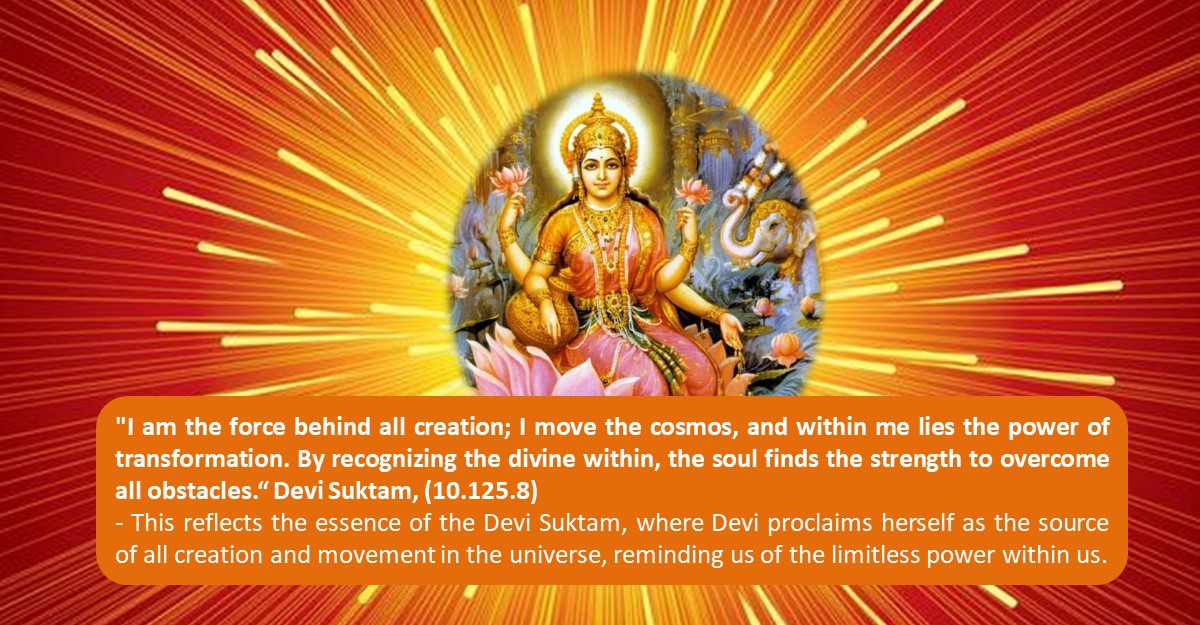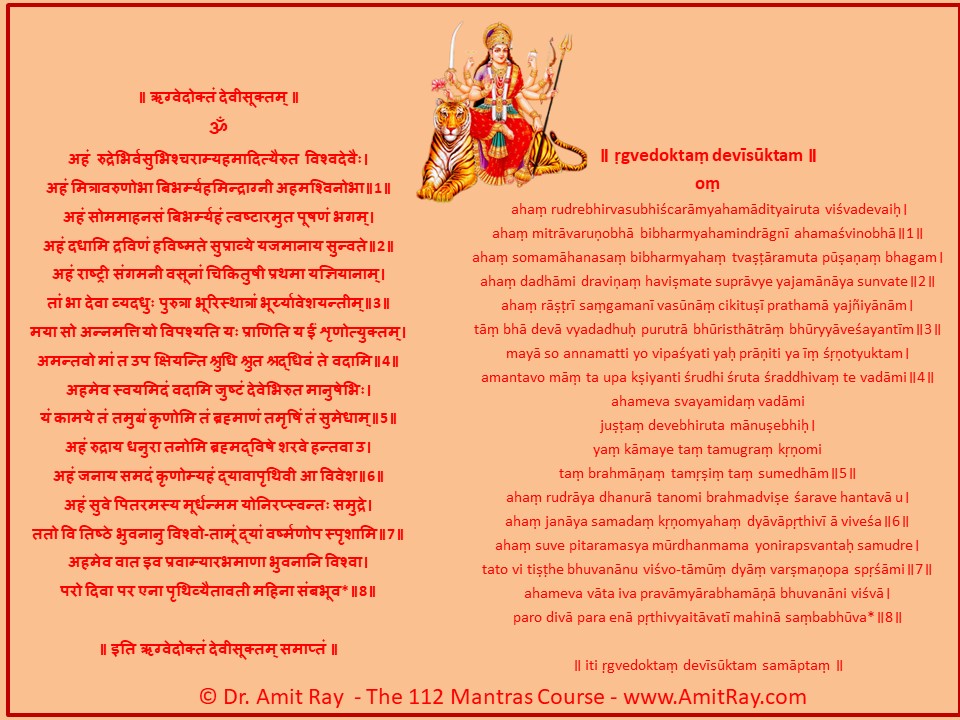The Devi Suktam is a profound hymn from the Rig Veda (Mandala 10, Hymn 125), wherein the goddess revealed herself as the supreme cosmic force that pervades all aspects of creation and beyond. Each verse of the Devi Suktam holds symbolic meanings, exploring philosophical themes of divine immanence, cosmic unity, and the relationship between the individual soul and the ultimate reality.

The Devi Suktam is frequently recited during rituals dedicated to the goddess, such as Navaratri or during the worship of deities like Durga, Lakshmi, Lalitambika, and Saraswati. Devi Suktam is part of Sri Vidya sadhana in our tradition. The Rig Veda Devi Suktam is a hymn of the Rigveda (RV 10.125), consists of 8 verses.

The hymn serves as both an invocation and a prayer for protection, prosperity, and wisdom. Through the recitations of these verses, devotees seek to align themselves with the divine qualities of the goddess and invite her presence into their lives.
The Two Devi Suktams
Meanings of the Eight Slokas of the Devi Suktam
1. Unity of the Divine and Cosmos (Verse 1)
“ॐ अहं रुद्रेभिर्वसुभिश्चराम्यहमादित्यैरुत विश्वदेवैः।
अहं मित्रावरुणोभा बिभर्म्यहमिन्द्राग्नी अहमश्विनोभा॥”
oṁ ahaṁ rud-re-bhir va-su-bhiś ca-rā-my aham ādityair uta viś-va-de-vaiḥ |
ahaṁ mitrā va-ru-ṇobhā bi-bhar-my aham indrā-agnī aham aś-vi-nobhā ||
In this verse, the goddess expresses her identification with various forms of deities, including Rudras (the gods of transformation), Adityas (solar deities), Vasus (elemental forces), and Vishvadevas (universal gods). She embodies Mitra (the god of friendship and cosmic order), Varuna (the god of flow, moral law, and life force), Indra (the king of all the gods), and the twin Ashvins (gods of health, healing, and medicine).
- अहं रुद्रेभिः वसुभिः च: “I am the Rudras and the Vasus.”
- राम्यहम्: “I am the essence, delightful.”
- आदित्यैः उत: “the Adityas also.”
- विश्वदेवैः: “the Vishvadevas.”
Key Theme: This suggests the philosophical idea that the goddess is not a separate deity but the very essence and core of the universe. The manifestation of different gods and forces represents diverse expressions of a single, underlying reality. This reflects the Vedantic concept of ekam sat, vipra bahudha vadanti (truth is one, but sages call it by many names).
2. Manifestation of Cosmic Powers (Verse 2)
“अहं सोममाहनसं बिभर्म्यहं त्वष्टारमुत पूषणं भगम्।
अहं दधामि द्रविणं हविष्मते सुप्राव्ये यजमानाय सुन्वते॥”
The goddess declares that she bears Soma, Tvashtar, Pusha, and Bhaga—representing nourishment, creation, and prosperity. She also states that she bestows wealth on those who offer sacrifices.
Key Theme: This verse reveals her role in the physical and spiritual nourishment of beings, through Soma (the drink of immortality and bliss) and her association with deities like Pusha (prosperity) and Tvashtar (the cosmic craftsman). She is both the cause of creation and its sustenance, signifying her nurturing aspect, not just in material wealth but in spiritual abundance as well. The mention of sacrifice (yajna) links her to the ritualistic and cosmic order, suggesting that divine grace flows to those who participate in the cosmic order through sacrifice and devotion.
3. Cosmic Sovereignty and Omnipresence (Verse 3)
“अहं राष्ट्री संगमनी वसूनां चिकितुषी प्रथमा यज्ञियानाम्।
तां भा देवा व्यदधुः पुरुत्रा भूरिस्थात्रां भूर्य्यावेशयन्तीम्॥”
Here, the goddess proclaims herself as the Rāṣṭrī (queen or sovereign), the ruler and gatherer of all riches. She is described as omnipresent, established by the gods in many places.
Key Theme: The term Rāṣṭrī emphasizes the goddess’s political and cosmic sovereignty. She embodies shakti, the divine feminine power, as the ruling force behind all that exists. Her omnipresence signifies that she is not confined to a particular domain but is the ruler of all realms, transcending physical and metaphysical boundaries. This highlights the non-duality of the divine presence and suggests that she governs all aspects of existence, from material wealth to spiritual enlightenment.
- भूरिस्थात्रां (bhūrīs-thā-trāṃ) – Goddess of abundant.
- भूर्य्यावेशयन्तीम् (bhūry-yā-veśayantīm)
- Abundance (भूरि – bhūri): Refers to plentifulness, richness, or abundance.
- Embellishing/Adorning (आवेशयन्तीम् – āveśayantīm): Refers to decorating or enhancing.
4. Divine Source of Life and Perception (Verse 4)
“मया सो अन्नमत्ति यो विपश्यति यः प्राणिति य ईं शृणोत्युक्तम्।
अमन्तवो मां त उप क्षियन्ति श्रुधि श्रुत श्रद्धिवं ते वदामि॥”
In this verse, the goddess states that she is the source of all sensory experiences and vital activities. Those who do not recognize her perish, and she commands attention to her words.
- “मया सो अन्नमत्ति” (mayā so annam atti): “Through me, one eats food” – meaning, all nourishment and sustenance are received through the divine energy.
- “यो विपश्यति यः प्राणिति” (yo vipaśyati yaḥ prāṇiti): “One who sees and one who breathes” – those who perceive and live, do so through the divine essence.
Key Theme: This underscores the goddess as the prāṇa, or life force, responsible for the sustenance of the entire creation. The verse reflects the Vedantic idea that the divine is the inner self or consciousness (ātman) that enables sensory perception and cognition. Failing to recognize the divinity within leads to spiritual ignorance, while understanding the divine nature brings knowledge and liberation. This highlights the centrality of self-awareness and the recognition of the divine in all aspects of life.
5. Grace and Empowerment (Verse 5)
“अहमेव स्वयमिदं वदामि जुष्टं देवेभिरुत मानुषेभिः।
यं कामये तं तमुग्रं कृणोमि तं ब्रह्माणं तमृषिं तं सुमेधाम्॥”
The goddess states that she bestows divine favor, turning the one she chooses into a Brahmana, a rishi, or a wise individual.
Key Theme: This verse emphasizes divine grace and free will. The goddess’s choice to empower individuals reflects the role of divine will in granting spiritual insight and strength. It also implies that divine favor is not based solely on merit, but on grace, indicating that human effort must be coupled with divine benevolence to achieve wisdom and spiritual advancement.
6. Cosmic Destruction and Harmony (Verse 6)
“अहं रुद्राय धनुरा तनोमि ब्रह्मद्विषे शरवे हन्तवा उ।
अहं जनाय समदं कृणोम्यहं द्यावापृथिवी आ विवेश॥”
Here, the goddess assists Rudra in destroying those who oppose wisdom. She also brings peace to people and permeates both heaven and earth.
Key Theme: This verse shows the dual nature of the goddess as both destroyer and sustainer. She destroys the enemies of knowledge and cosmic order, but she also brings peace and harmony. This reflects her aspect as Shakti, the dynamic force behind creation and destruction, in alignment with the cosmic rhythm of sṛṣṭi (creation), sthiti (sustenance), and laya (destruction).
7. Cosmic Creation and Expansion (Verse 7)
“अहं सुवे पितरमस्य मूर्धन्मम योनिरप्स्वन्तः समुद्रे।
ततो वि तिष्ठे भुवनानु विश्वो-तामूं द्यां वर्ष्मणोप स्पृशामि॥”
The goddess claims to have given birth to the creator of the universe, with her origin in the cosmic waters, from where she expands to all realms.
Key Theme: This verse presents the goddess as the primal mother, originating from the cosmic waters (apsu), an ancient Vedic symbol for the primordial state of the universe. The idea that she gives birth to the Creator emphasizes her foundational role in the cosmic order. Her expansion into all realms suggests the boundless nature of her existence, symbolizing the cyclical creation and dissolution of the universe.
8. Limitless Power and Transcendence (Verse 8)
“अहमेव वात इव प्रवाम्यारभमाणा भुवनानि विश्वा।
परो दिवा पर एना पृथिव्यैतावती महिना संबभूव॥”
The goddess compares herself to the wind, moving and creating all worlds. She transcends both heaven and earth, symbolizing her limitless power.
Key Theme: The wind symbolizes an all-pervasive, dynamic force, suggesting that the goddess is the unseen power that moves and sustains the entire cosmos. Her transcendence beyond both heaven and earth points to the idea that she is beyond the constraints of time, space, and matter. This reflects her infinite, formless nature and omnipresence.
Rig Veda Devi Suktam Sanskrit
॥ देवीसूक्तम् ॥
ॐ अहं रुद्रेभिर्वसुभिश्चराम्यहमादित्यैरुत विश्वदेवैः।
अहं मित्रावरुणोभा बिभर्म्यहमिन्द्राग्नी अहमश्विनोभा॥1॥
अहं सोममाहनसं बिभर्म्यहं त्वष्टारमुत पूषणं भगम्।
अहं दधामि द्रविणं हविष्मते सुप्राव्ये यजमानाय सुन्वते॥2॥
अहं राष्ट्री संगमनी वसूनां चिकितुषी प्रथमा यज्ञियानाम्।
तां भा देवा व्यदधुः पुरुत्रा भूरिस्थात्रां भूर्य्यावेशयन्तीम्॥3॥
मया सो अन्नमत्ति यो विपश्यति यः प्राणिति य ईं शृणोत्युक्तम्।
अमन्तवो मां त उप क्षियन्ति श्रुधि श्रुत श्रद्धिवं ते वदामि॥4॥
अहमेव स्वयमिदं वदामि जुष्टं देवेभिरुत मानुषेभिः।
यं कामये तं तमुग्रं कृणोमि तं ब्रह्माणं तमृषिं तं सुमेधाम्॥5॥
अहं रुद्राय धनुरा तनोमि ब्रह्मद्विषे शरवे हन्तवा उ।
अहं जनाय समदं कृणोम्यहं द्यावापृथिवी आ विवेश॥6॥
अहं सुवे पितरमस्य मूर्धन्मम योनिरप्स्वन्तः समुद्रे।
ततो वि तिष्ठे भुवनानु विश्वो-तामूं द्यां वर्ष्मणोप स्पृशामि॥7॥
अहमेव वात इव प्रवाम्यारभमाणा भुवनानि विश्वा।
परो दिवा पर एना पृथिव्यैतावती महिना संबभूव*॥8॥
॥ इति ऋग्वेदोक्तं देवीसूक्तम् समाप्तं ॥
Benefits of Chanting and Meditating Devi Suktam
As the hymn praises the Goddess Vak, as the source of speech and inspiration, it enhances creative expression and communication skills. Those engaged in creative fields like writing, arts, and public speaking can benefit significantly from this hymn.
Meditating on the Devi Suktam helps devotees establish a deep connection with the divine cosmic divine energy. This connection helps individuals embrace qualities such as compassion, nurturing, love, and grace.
The hymn is said to help in manifesting positive outcomes, success, and prosperity in various endeavors. It aligns one’s goals and aspirations with divine will, leading to the successful realization of desires.
Reciting the Devi Suktam offers a pathway to mental tranquility, balancing emotions and promoting deep inner peace. The hymn’s sacred vibrations resonate with the body and soul, promoting healing and vitality, while awakening higher wisdom and spiritual insight. The Goddess, as the embodiment of creative power, blesses devotees with enhanced creativity, eloquence, and expression, making it a powerful tool for artists, thinkers, and seekers of truth.
Moreover, the Devi Suktam is said to aid in the manifestation of desires, bringing prosperity, success, and fulfillment. It acts as a spiritual bridge, connecting individuals to the universal feminine energy, nurturing compassion, love, and grace, while ultimately guiding them towards liberation and divine union with the cosmic consciousness.
Divine Grace and Liberation (Moksha)
Ultimately, the Devi Suktam is a path to receiving the grace of the Divine Mother. It helps devotees move towards the ultimate goal of liberation (moksha), transcending worldly attachments, and realizing the oneness with the cosmos.
- Liberation from Cycles of Suffering: The hymn guides practitioners toward liberation by detaching from material desires and attachments.
- Divine Bliss and Union: Fosters a sense of divine union and blissful connection with the cosmic consciousness.
Conclusion:
The Devi Sukta provides a multidimensional portrayal of the goddess as the supreme, immanent, and transcendent power behind all creation, sustenance, and dissolution. She is simultaneously the nurturing force that empowers life and the destructive force that removes ignorance and restores cosmic order. Through her grace, she grants wisdom, wealth, and spiritual insight to devotees, while those who fail to recognize her perish in ignorance.
Philosophically, the hymn supports a non-dualistic view of reality, where the divine is both the manifest world and the unmanifest transcendent force. This aligns with later Vedantic and Tantric interpretations of the goddess as Shakti, the dynamic energy of the universe, inseparable from Brahman, the absolute reality.
